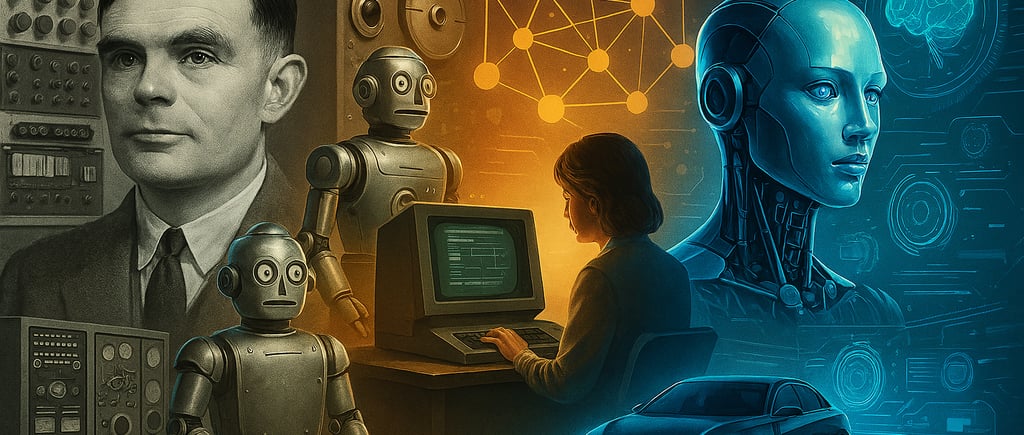The History of Artificial Intelligence: From Concept to Reality
8/9/20255 min read



The Early Beginnings of Artificial Intelligence
The journey of artificial intelligence (AI) began in the mid-20th century, marked by pioneering ideas and groundbreaking research that laid the foundation for the field as we know it today. Central to these early developments was the British mathematician and logician Alan Turing, whose work significantly influenced the conceptual framework of AI. In 1950, Turing proposed the famous Turing Test, a seminal notion in evaluating machine intelligence. The test posited that if a machine could engage in a conversation indistinguishable from that of a human, it could be deemed intelligent. This philosophical exploration of machine thought catalyzed interest and research into AI technologies.
In addition to Turing, the 1940s and 1950s saw a burgeoning of ideas around the potential of machines to perform tasks that traditionally required human intelligence. Early computers, developed for complex calculations, sparked imagination among researchers regarding their capabilities beyond arithmetic. The concept of neural networks, inspired by the structure of the human brain, began to take shape during this era. Initial models, such as the perceptron created by Frank Rosenblatt in 1958, were designed to simulate the way neurons process information. These models aimed to bridge the gap between biological understanding and computational capability, heralding a new era in machine learning.
Moreover, the Dartmouth Conference of 1956 is often cited as the birth of AI as a formal academic discipline. During this workshop, leading figures convened to discuss the possibility of creating machines that could simulate intelligent behavior. The optimism and collaborative spirit of this meeting set the stage for significant advancements in AI, eventually leading to the development of various algorithms and systems. These early efforts, while rudimentary by today's standards, established pivotal concepts and methodologies that continue to drive AI research and applications in contemporary society. The foundational work of this era is essential for understanding how AI evolved from abstract theories to practical implementations.
Milestones in AI Development
The evolution of artificial intelligence from conceptual frameworks to practical applications took significant strides between the 1960s and 1980s, marked by key milestones that shaped the field. During this period, one of the most notable advancements was the development of expert systems. These AI programs were designed to simulate the decision-making abilities of a human expert, allowing for complex problem-solving in specialized domains such as medicine, geology, and finance. For instance, MYCIN, an early expert system developed in the 1970s, was designed to diagnose bacterial infections and recommend antibiotics, showcasing how machines could augment human expertise.
In parallel with the rise of expert systems, advancements in algorithms significantly propelled AI research forward. The introduction of heuristic search methods and the refinement of common-sense knowledge bases led to more efficient and effective problem-solving capabilities in AI applications. Notably, the A* algorithm, which was developed in the early 1970s, became instrumental in pathfinding and graph traversal—yet another demonstration of how critical algorithmic innovations were to the functionality of AI systems.
Natural language processing (NLP) also saw remarkable progress during this era. Early AI programs, such as ELIZA, created in the mid-1960s by Joseph Weizenbaum, managed to engage users in naturalistic dialogue, mimicking human conversation through pattern matching. This demonstrated an early potential for machines to understand and process human language, laying foundational groundwork for future advancements in NLP. As a result, these milestones underscored the burgeoning capabilities of AI, highlighting the transition from mere theoretical constructs to tangible applications that could perform tasks traditionally reliant on human intellect.
Breakthroughs in Machine Learning and Deep Learning
The evolution of artificial intelligence (AI) has seen remarkable breakthroughs in machine learning and deep learning since the 1990s, marking a significant transition from rule-based systems to models that can autonomously learn from data. One of the most significant advancements during this period was the development of support vector machines (SVMs), which established a framework for both classification and regression tasks. SVMs offered a robust mechanism for handling high-dimensional spaces and became instrumental in various applications, including image recognition and text classification.
Following the SVM era, the rise of neural networks with multiple layers, often referred to as deep learning, ushered in an unprecedented capability for AI systems. This innovation enabled the processing of large volumes of data through layered architectures that mimic human brain functions. The advent of graphics processing units (GPUs) provided the necessary computational power to train large neural networks, significantly enhancing their performance and efficiency. Deep learning's ability to extract intricate features from data allowed for breakthroughs in complex tasks such as speech recognition, natural language processing, and computer vision.
Moreover, the acceleration of AI advancements has been driven by the availability of big data. The digital universe now contains vast amounts of structured and unstructured data, and this wealth has proved invaluable for training machine learning models. Organizations such as Google, Facebook, and Microsoft have made substantial contributions to machine learning and deep learning research, facilitating an ecosystem where collaborative innovation thrives. Influential figures, including Geoffrey Hinton, Yann LeCun, and Yoshua Bengio, have laid foundational work that has inspired countless developments in the field.
As machine learning and deep learning technologies continue to evolve through ongoing research and application, their impacts on various industries are becoming increasingly profound, shaping the future of AI in ways previously imagined only in science fiction.
The Present and Future of AI
The current state of artificial intelligence (AI) is characterized by significant advancements across numerous sectors, reflecting its versatile applications in today’s world. AI technologies have permeated various industries such as healthcare, finance, transportation, and entertainment, greatly enhancing operational efficiencies, personalizing customer experiences, and enabling data-driven decision-making. In healthcare, for instance, AI algorithms are being employed to predict patient outcomes, streamline diagnostic processes, and even assist in surgical procedures. These applications demonstrate AI's potential to transform traditional practices into more efficient systems.
One of the key focus areas in AI development is natural language processing (NLP), which has made monumental strides in the past few years. NLP technologies enable machines to comprehend and generate human language, facilitating more meaningful interactions within customer service platforms and personal assistant applications. Moreover, in the realm of computer vision, AI algorithms have improved immensely in their ability to interpret visual information, influencing areas such as security, autonomous vehicles, and advanced imaging analysis.
Looking forward, the future of artificial intelligence is poised to be even more transformative. Several trends are emerging that may shape the trajectory of AI technology, including the increased emphasis on ethical AI practices. As AI becomes increasingly integrated into daily life, ongoing discussions about its implications are paramount. Concerns regarding data privacy, algorithmic bias, and the potential displacement of jobs are sparking critical dialogues among stakeholders. Additionally, innovative breakthroughs in AI, such as explainable AI and emotional intelligence, may enhance trust and human interaction with machines, promoting broader acceptance within society.
As we contemplate the future of artificial intelligence, it becomes essential to question how these advancements may redefine our societal frameworks, influence human interaction, and guide ethical governance around technology. The journey of AI is undoubtedly ongoing, and its evolution will require careful consideration of both its vast potential and the inherent challenges that accompany its integration into various aspects of life.

